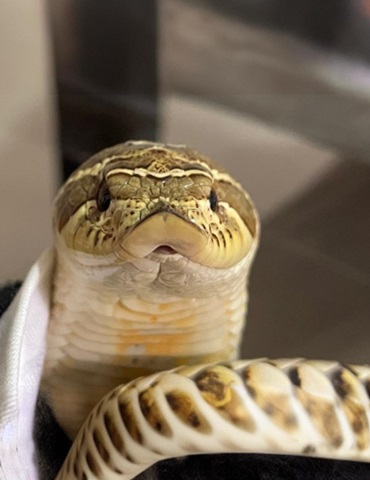In the fascinating world of reptiles, the hognose snake has won the affection of many due to its unique appearance and intriguing behaviors. Primarily found in North America, this snake species exhibits a distinctive body structure. They are relatively stout, with adults typically measuring between 30 and 120 cm in length. Male hognose snakes generally reach 38-60 cm, while females often grow to 70-100 cm or larger.
Hognose snakes feature a large head that is clearly distinct from the neck. Their necks possess a unique ability to expand, similar to cobras, as a defensive display when threatened. Rest assured, hognose snakes are usually non-venomous. They have short tails and two anal scales. Their skin displays a rich variety of colors and patterns, including brown and gray, with different subspecies showcasing uniquely beautiful markings bestowed by nature. The behavior of hognose snakes is quite fascinating. They derive their name from their upturned, pig-like snout, which not only gives them a charmingly cute appearance but also serves as a practical tool for digging and underground exploration. Most hognose snakes are docile and rarely initiate attacks. When feeling threatened, they first attempt to avoid predators by playing dead—rolling over, opening their mouths, sticking out their tongues, and even emitting a foul odor to convincingly mimic death, which is both amusing and effective. In terms of diet, hognose snakes primarily feed on frogs, toads, and small lizards. Despite their appealing traits, keeping them as pets requires an understanding of relevant legal regulations and providing suitable living conditions and proper nutrition. This includes a quiet, dry, well-ventilated enclosure with appropriate temperatures. An adequately sized terrarium with substrate such as akadama soil or paper towels is recommended. A water dish should be provided for drinking and soaking. Heating pads and thermostats can be used to maintain an optimal temperature range of 26-32°C, with humidity around 50%-70%. Feeding options include small mice or hamsters, ensuring the prey size matches the snake’s gape to avoid issues. Hognose snakes may exhibit picky eating habits, so offering varied food items can help stimulate their appetite. Feeding frequency should be adjusted based on the snake’s age and size, with younger snakes requiring more frequent meals and adults fed less often.It is recommended to feed 1-2 times per week. During the care of hognose snakes, close monitoring of their health condition is essential. Observe changes in behavior, appetite, breathing, and other aspects. If any abnormalities are detected, take prompt measures or consult a veterinarian for advice.
Hognose snakes are relatively timid and easily frightened. During the care process, avoid excessive disturbance or startling the snake. Provide them with a quiet and comfortable living environment.


